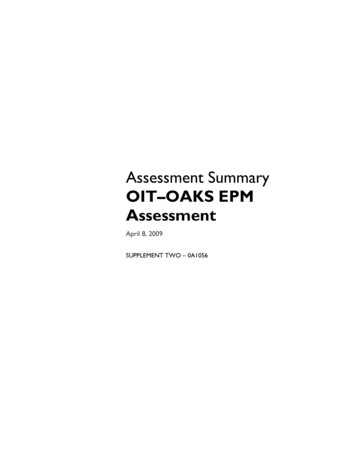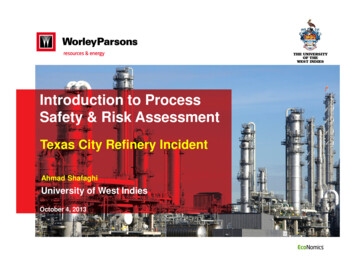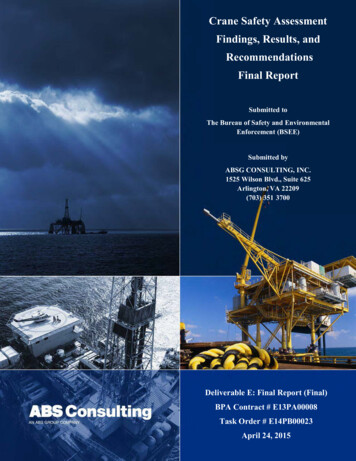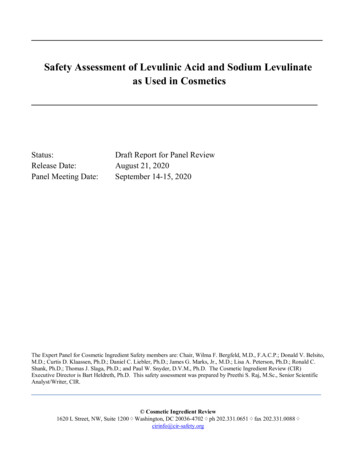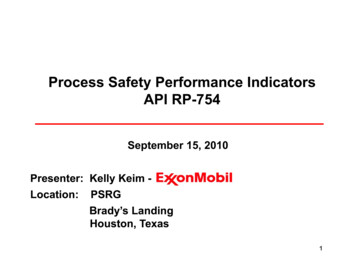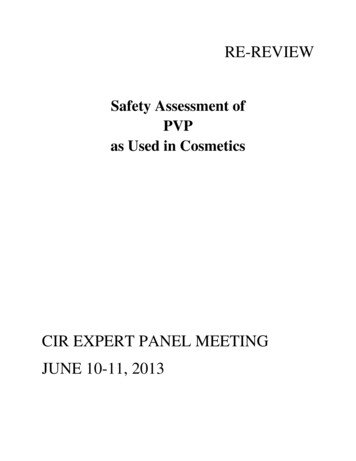
Transcription
RE-REVIEWSafety Assessment ofPVPas Used in CosmeticsCIR EXPERT PANEL MEETINGJUNE 10-11, 2013
Commitment & Credibility since 1976MemorandumTo:From:Date:Subject:CIR Expert Panel Members and LiaisonsChristina L. BurnettScientific Writer/AnalystMay 17, 2013Re‐review of Polyvinylpyrrolidone (PVP)In 1998, the CIR Final Report on the safety assessment of polyvinylpyrrolidone (PVP) was published with the conclusion“safe as used in cosmetics”.Current uses of PVP can be found in Table 1. The FDA’s VCRP database indicates that uses have nearly doubled from 395to 799. The majority of the uses are in leave‐on products such as eye makeup and hair tonics and dressings. In 1998, theindustry reported a maximum use concentration range of 0.15% to 35%, with the higher end of the range reported inmakeup fixative. Presently, the industry reported a maximum use concentration range of 0.0005% to 94%.A few case studies related to allergic reactions to PVP have been reported and those studies have been included in this re‐review.Because of similarities in chemical structure and because the supporting safety data were used in the original report, theingredient PVP‐iodine could be potentially added to the safety assessment. PVP‐iodine is the active ingredient in suchantiseptics as Betadine and is an approved OTC drug. There are currently no reported uses of PVP‐iodine in cosmetics.Literature searches yielded numerous hits. Literature on efficacy as an antiseptic and cytotoxicity have been largelyexcluded from the re‐review. Studies that pertained to allergic reaction, via dermal or other exposure, have beenincorporated as has an inhalation study and genotoxicity findings.The task for the Panel at this meeting is to determine whether the conclusion on PVP is still valid. If it is not, anamendment should be initiated. The Panel should also decide whether or not to reopen the safety assessment to addPVP‐iodine.1101 17th Street, NW Suite 412, Washington, DC 20036(Main) 202-331-0651 (Fax) 202-331-0088(Email) cirinfo@cir-safety.org (Website) www.cir-safety.org
vPJL,V cISAFETY ASSESSMENT FLOW CHARTLnJ4-Draft AmendedReport60 day public comment periodGreen Cover 1timeDraft AmendedTentative ReportTentative AmendedReportDraft Amended FinalReportPUBLISH 4Final Repoi*The CIR Staff notifies of the public of the decision not to re-open the report and prepares a draft statement for review bythe Panel. After Panel review, the statement Is issued to the Public.**lf Draft Amended Report (DAR) is available, the Panel may choose to review; If not, CIR staff prepares DAR for PanelReview.Expert Panel Decision3
CIR HistoryPvP1001/84Scientific Literature Review: February 21, 1995PVP is a Wyden ingredient.On May 11th, Dr. David Bower of ISP phoned to say that his company hadcomments and would be sending a book to be incorporated into the review.On May15th, I received PVP: A Critical Review of the Kinetics and Toxicology ofPolyvinylpyrrolidone (Povidone) by Robinson, Sullivan, Borzelleca, and Schwartz,published by Lewis Publishers, 1990. However, a draft of this book (from 1985)hadbeen received through an FOI request to the FDA. Therefore, most of the informationcontained in the book was already contained in the CIR report (albeit with anunpublished report citation).Draft Report (1st Review): May 22, 1995After review of the document, the teams requested the following data informally.Both Teams:(1) Concentration of Use (and Molecular Weight of PVP used in cosmetics)(2) Impurities (especially hydrazine)(3) dermal irritation and sensitization(4) UV absorption, if absorbed in the UVA or UVB range photosensitization will be needed.In addition the Belsito team also requested:(5) Particle size information with regards to aerosols, if respirable then an inhalation studyisneeded.The Schroeter team also requested:(6) Chemical and Physical properties.With regard to request #5, the Belsito team noted that the NOAEL for NVP was 5 ppm and that in the absence of particle size information and/or inhalation studiesonthe polymer, a concentration limit for aerosol products would be needed.The Belsito team requested that the Whitacre and Crockett (1990) study bedeleted as it involved injection of PVP-iodine into the eye and therefore was not usefulin the safety assessment.Both teams recognized that PVP is a foreign-body type tumor-producing polymer.Redlined articles denote items that may be addressed in the PVP book byRobinson et al., 1990.On July 6th, a request was received from ISP through CTFA requesting that thereview be post-poned (from the August meeting) so that additional data can besubmitted. Included with the letter was a summary of various published studies.On July 14 and 17, 1995 CTFA submitted data concerning concentration of use.On July 31, 1995 I phoned Dr. Bower at ISP to ask what specific studies theywould be sending. He stated that phototoxicity and photoallergenicity studies aswell asinformation regarding the hydrazine impurity should arrive at CIR before the Augustmeeting. He stated that PVP (usually K30) was used at concentrations between 1-2%(it can go up to 3% but that would be “aesthetically unacceptable”). Upon my asking, heestimated that PVP K90 (used in aerosol hair sprays) had a MW of 360,000. He alsostressed that the Panel should remove studies concerning PVP-iodine.On August 16, 1995 the following unpublished data were received: 13-weekdermal toxicity in rats, human patch test, and clinical maximization assay. A memowasprepared summarizing these studies and mailed to the Expert Panel on August 21st.
Copies of the data were brought to the August meeting.Draft Report (2nd Review)ITentative Report #1: August 29, 1995At this meeting, the Panel felt there was sufficient data to issue a TentativeReport with a safe up to 10% conclusion. The discussion section will note the lack ofUV-absorption data but will note the historical use of the ingredient in a variety ofsettings without incidence. The Panel is also aware that phototoxicity andphotoallergenicity data have been promised (though not received in time to be reviewedat this meeting) and that the arrival of these studies may/will change the discussionsection as warranted.The Panel also electedto delete the studies on PVP-iodine as in certainsections these are the only data available. In fact, the 10% limit is based on a clinicalRIPT that tested the PVP-iodine complex.On August 31, 1995 CTFA submitted the following from ISP and BASF:information concerning impurities, UV absorbance, phototoxicity and photosensitization,dermal irritation and sensitization, and particle size information.On September 13, 1995 Dr. Bower phoned CIR. He thought the 10% limit to betoo low as the ingredient is a non-absorbing polymer with OTC use and an acceptabledaily intake (ADI) of 50 mg/kg set by the W.H.O. 1 explained that it was based on thehighest concentration tested in an RIPT assay and that the RIPT his companysubmitted on 8/31/95 (which tested undiluted PVP) was not received in time for reviewat this meeting, but that this study would probably be sufficient to raise the limit. Heagreed to send a letter specifically requesting a higher (or no) limit.On October 17, CTFA submitted data from photosensitization andphotoallergenicity studies. These data were a duplicate of the studies received onAugust 31, 1995. In his cover letter, Dr. McEwen recommended that the 10% limitationbe removed.Tentative Report #21(3rd review): December 12, 1995In view of the submitted clinical data which tested undiluted PVP, the Panel reissued a Tentative report with a “safe as used” conclusion.December 13, 1995.No comments were received during the 90-day comment period.Final Report: June 4, 1996
Polyvinyl Alcoholg, the PanelDr. Belsito noted that at the December 11-12, 1995 Panel meetinsion: Based on thevoted in favor of issuing a Tentative Report with the following concluto be safe for use inavailable data, the CIR Expert Panel concludes Polyvinyl Alcoholcosmetic formulations.Report with theThe Expert Panel voted unanimously in favor of issuing a Finalabove conclusion.PVP (Polyvinyl Pyrrolidone)meeting, the PanelDr. Schroeter noted that at the December 11-12, 1995 Panelconclusion: Based on thevoted in favor of issuing a Tentative Report with the followinginyl Pyrrolidone) is safeavailable data, the CIR Expert Panel concludes that PVP (Polyvas used in cosmetics.Report with theThe Expert Panel voted unanimously in favor of issuing a Finalabove conclusion.lodopropynyl Butylcarbamateg, the PanelDr. Belsito noted that at the December 11 -12, 1995 Panel meetinconclusion: On the basisvoted in favor of issuing a Tentative Report with the followingdes that lodopropynylof the data presented in this report, the CIR Expert Panel conclutrations ofButylcarbamate (IPBC) is safe as a cosmetic ingredient at concenlized.IPBC should not be used in products intended to be aeroso-14-0.1%.
PVP History1998 - CIR published the safety assessment on polyvinylpyrrolidone (PVP) with the conclusion“safe as used in cosmetics”.
Method of MfgToxicokineticsXXXXProfile takes in account data from the original report.PVP-Iodine“X” indicates that data were available in the category for that Case StudiesXOcular IrritationCarcinogenicity/Tumor PromotonDermal Irritation –Non-HumanDermal IrritationHumanDermal Sens – NonHumanDermal Sens –HumanGenotoxicityRepeated Dose OtherRepro/Dev ToxXRepeated Dose -IVRepeated Dose DermalRepeated Dose OralRepeated Dose InhalationAcute Tox - OtherAcute Tox - IVAcute Tox InhalationAcute Tox - OralAcute Tox - DermCompositionPVPIn-UsePVP Data Profile* – June 2013 – Writer, Christina BurnettXXXXXXX
Search Strategy for PVP and PVP-IodineMarch - April 2013: SCIFINDER search for PVP and PVP-Iodine using INCI name, CAS# and “povidone”-For PVP, limited search for time period since 1998.Limited for adverse effects, including toxicity - 57 references came back for PVP.Limited for adverse effects, including toxicity – 137 references came back for PVP-Iodine.PVP, limit since 1998Povidone, limit 1-8Total references ordered: 63TOXLINE, minus 72186
Polyvinylpyrrolidone (PVP) as Used in CosmeticsStatus:Release Date:Panel Meeting Date:Re-review draft for CIR Panel ReviewMay 17, 2013June 10-11, 2013The 2013Cosmetic Ingredient Review Expert Panel members are: Chairman, Wilma F. Bergfeld, M.D., F.A.C.P.; Donald V.Belsito, M.D.; Ronald A. Hill, Ph.D.; Curtis D. Klaassen, Ph.D.; Daniel C. Liebler, Ph.D.; James G. Marks, Jr., M.D., RonaldC. Shank, Ph.D.; Thomas J. Slaga, Ph.D.; and Paul W. Snyder, D.V.M., Ph.D. The CIR Director is F. Alan Andersen, Ph.D.This report was prepared by Christina Burnett, Scientific Analyst/Writer.Cosmetic Ingredient Review1101 17th Street, NW, Suite 412 Washington, DC 20036-4702 ph 202.331.0651 fax 202.331.0088 cirinfo@cir-safety.org1
INTRODUCTIONIn 1998, the Cosmetic Ingredient Review (CIR) published the safety assessment on polyvinylpyrrolidone (PVP) withthe conclusion “safe as used in cosmetics”.1 PVP functions as a binder, dispersing agent – nonsurfactant, emulsion stabilizer,film former, and hair fixative in cosmetic products.2 The majority of the uses of PVP are in eye makeup and non-coloringhair products.3Because of similarities in chemical properties and structure, PVP-iodine complex could be potentially added to thesafety assessment on PVP. Data on this ingredient were incorporated in the original safety assessment on PVP because theywere deemed relevant at the time. PVP-iodine is the active ingredient in the topical antiseptic Betadine.Since the original review, numerous additional published studies related both of these ingredients have beendiscovered. A few of these studies are summarized in this re-review document. Efficacy studies on PVP-iodine as anantiseptic and cytotoxicity studies on this ingredient have been largely excluded from this review.CHEMISTRYDefinitions and StructuresThe definition and structure of PVP (CAS # 9003-39-8) can be found in the original safety assessment.1 PVP-iodine(CAS # 25655-41-8 ) is defined as a complex of polyvinylpyrrolidone and iodine.2Physical and Chemical PropertiesPhysical and chemical properties of PVP can be found in the original safety assessment.1USECosmeticTable 1 presents the historical and current product formulation data for PVP. PVP functions as a binder, dispersingagent – nonsurfactant, emulsion stabilizer, film former, and hair fixative in cosmetic products.2 According to informationsupplied to the Food and Drug Administration (FDA) by industry in 1998, PVP had 395 reported uses, with the majority ofthe uses reported in leave-on products such as eye makeup. Industry reported maximum use concentration ranges for PVP of0.15% to 35%, with the higher end of the range reported in makeup fixatives. Currently, the FDA’s Voluntary CosmeticRegistration Program (VCRP) database indicates that uses have increased for PVP, which now has 799 reported uses, withthe majority of the uses reported in leave-on products such as eye makeup and hair tonics and dressings. A survey of useconcentrations conducted by the Personal Care Products Council (Council) reported maximum concentration of use ranges of0.0005% to 94%.4PVP-iodine complex has no reported uses.The PVP are not restricted from use in any way under the rules governing cosmetic products in the EuropeanUnion.5 PVP-iodine complex is not a registered cosmetic ingredient in Europe.Non-CosmeticPVP-iodine is a FDA approved drug product. It is an approved over-the-counter antifungal drug at concentrationsup to 10% (21 CFR §333.210). It is also present as an active ingredient in over-the-counter topical acne drug products,dandruff/seborrheic dermatitis/psoriasis treatment; however, there are inadequate data to establish general recognition of thesafety and effectiveness of the ingredient for these specified uses (21 CFR §310.545).PVP-iodine ointment may be a protective agent against skin toxicity caused by thermal weapons and chemicalweapons such as mustard gas.76TOXICOKINETICSNo new relevant studies were found in the published literature.TOXICOLOGICAL STUDIESAcute ToxicityInhalation – Non-HumanPVP-IodineLung injury, including pulmonary fibrosis, was observed following aspiration of PVP-iodine in rats.8 MaleSprague-Dawley rat lungs (61 animals total) were instilled via endotracheal intubation with varying volumes of eitherphosphate-buffered saline or PVP-iodine solutions (0.01% to 10%). The rats were killed 1 h or 1, 3, 5, 7, 14, or 21 days afterinstillation. The tissues underwent radiologic, macroscopic, and microscopic (light and scanning electron) examination.Pulmonary toxicity was also assessed with an MTT-based cytotoxicity assay. Atelectasic lesions were observedmacroscopically and edema, alveolar rupture, and leukocyte infiltration into the pulmonary interstitium were observed2
microscopically. Progression into lung parenchyma loss and scar tissue formation were also observed. The lung tissueviability following 1 day exposure to 0.01% to 5% PVP-iodine decreased in a significant dose-dependent manner.REPRODUCTIVE AND DEVELOPMENTAL TOXICITYNo new relevant studies were found in the published literature.GENOTOXICITYIn VitroPVP-IodineThree formulations containing PVP-iodine were not gentoxic in a comet assay or a chromosome aberration test, withor without metabolic activation.9 The solutions contained 3% or 10% PVP-iodine. In both tests, CHO-K1 cells were exposedfor 4 h to the test solutions. Expected results were observed with positive and negative controls.CARCINOGENICITYNo new relevant studies were found in the published literature.IRRITATION AND SENSITIZATIONIrritationOcular – Non-HumanPVP-IodinePVP-iodine was severely toxic to corneal endothelium at concentrations of 5% and 10% in a rabbit eye model.10 Inanother rabbit study, significant corneal damage was observed at concentrations of 1.5% and higher.11 An in vitro study ofcultured bovine corneal endothelial cells with PVP-iodine concentrations up to 0.1% found that concentrations of 0.05% orless did not induce endothelial cell damage.12 This research also performed an in vivo study on rabbits with PVP-iodine up to1% and found concentrations of 0.1% or less did not damage corneal endothelium.SensitizationDermal - HumanPVP-IodineIn patch testing of 500 consecutive patients with 10% PVP-iodine solution (diluted 10 times in water, readings ondays 2 and 4), 14 patients (2.8%) had a positive reaction to the test material.13 These patients then underwent repeated openapplication tests (ROAT) with a PVP-iodine solution and only 2 of the 14 patients tested positive. The authors of the studyconcluded that only 2 of the 500 patients (0.4%) had true allergic contact dermatitis from PVP-iodine.The irritation and sensitization potential of different preparations that contain iodine, including PVP-iodine, wasinvestigated in 24 fair-skinned, healthy subjects without a history of iodine allergy.14 PVP-iodine was tested atconcentrations of 1%, 5%, 7.5%, and 10% on the intrascapular area on the back or on the volar foreman with Finn Chamberson Scanpor tape. The test materials were applied for 2 days. The test sites were read on day 2 and day 4 after patchapplication. Only 1 subject reacted to PVP-iodine, at concentrations of 7.5% (vesiculation on day 4) and 10% (definiteerythema on day 4).Patch testing was performed on 10 patients with the history of contact dermatitis following application of PVPiodine preparations and who had positive patch tests with the preparations.15 The 2-day closed testing was conducted usingFinn Chambers on Scanpor tape with samples of 2 PVP-iodine preparations and their individual ingredients and components,including PVP-iodine (1%, 2%, 5%, and 10% aq.), PVP (1%, 2%, 5%, and 10% aq.), and iodine (0.2% gel). Reactions werescored 30 min and on day 3 and day 5 post-application. On days 3 and 5, “ ” reactions or stronger were observed in 10/10patients with 10% PVP-iodine, in 9/9 patients with 5% PVP-iodine, and in 5/9 patients with 2% PVP-iodine. All patients(10/10) had positive reactions to the PVP-iodine preparation tested neat, but the reactions were irregular. Only 1/9 patientshad a positive reaction to 0.2% iodine and none of the patients had a strong reaction to any of the PVP patches. In the controlgroup, “ ” reactions were observed in 3/10 to 5% and 10% PVP-iodine and to the PVP-iodine preparation. No reactionswere observed to the lower concentrations or to any of the other components tested. The authors concluded that the strongreactions to 4/10 patients were allergic sensitization while the other reactions were irritation reactions.In a survey of physicians in Japan for occupational allergy, 17 out of 307 reported contact allergy to PVP-iodine.CLINICAL USECase StudiesA 59-year-old woman with pollinosis developed anaphylaxis after vaginal application of a PVP-iodine solution fordisinfection during a medical examination.16 On the following day, she was observed with several wheals and flares on herbody as well as slight dyspnea. Her symptoms subsided after 3 days. Previously, she had had several episodes of contact3
urticarial after using a permanent wave solution and a shampoo. Wheal and flare responses (3 ) to the PVP-iodine solution(10% aq.), PVP-iodine (0.1% aq.) and PVP (0.001% aq.) were observed following prick tests; however, no reactions wereobserved to iodine or polyoxyethyrenenoylphenyl ether, which were also components of the PVP-iodine solution. Thepatient’s shampoo and permanent wave solution (1% aq.) as well as the individual components of each (0.02% aq.) were alsotested, and positive (2 ) reactions were observed to the shampoo and the permanent wave solution and the components PVPN,N-dimethyl aminoethyl methacrylic acid copolymer diethyl sulfate solution and
This report was prepared by Christin a Burnett, Scientific Analyst/Writer. Cosmetic Ingredient Review 1101 17th Street, NW, Suite 412 Washing

